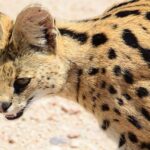Axolotls, with their perpetually smiling faces and unique charm, have captured the hearts of pet enthusiasts worldwide. However, the question “Can U Have A Pet Axolotl?” isn’t always straightforward. Many aspiring axolotl owners are surprised to learn that owning these fascinating amphibians is illegal in certain regions, including some US states and Canadian provinces, as well as other parts of the globe. In the United States, axolotl ownership is prohibited in California, Maine, New Jersey, and Washington D.C., while permits are necessary in New Mexico and Hawaii. Similarly, in Canada, axolotls are banned in New Brunswick, British Columbia, and Prince Edward Island, with Nova Scotia requiring a permit. While these restrictions might be disappointing for those living in these areas, it’s crucial to understand that these regulations are implemented for significant environmental reasons.
Why the Ban? The Environmental Concerns Behind Axolotl Ownership Restrictions
It’s a common misconception that axolotl bans are primarily due to the critically endangered status of wild axolotls. While it’s true that wild axolotl populations are dwindling drastically and face imminent extinction in their natural habitat, this isn’t the primary driver behind ownership restrictions. The axolotls kept as pets today are descendants of captive breeding programs spanning multiple countries, far removed genetically and behaviorally from their wild counterparts. These pet axolotls have been bred in captivity for generations, leading to significant differences from wild axolotls.
Captive axolotls are often crossbred with tiger salamanders and have even been subject to genetic modifications, such as the introduction of the GFP (Green Fluorescent Protein) gene. Furthermore, generations of breeding in controlled environments, devoid of natural selection pressures, have resulted in captive axolotls becoming almost distinct from their wild relatives. This divergence is a key reason why releasing pet axolotls into Lake Xochimilco, their native Mexican habitat, would not contribute to the conservation of wild axolotls.
Leucistic axolotl photograph showcasing traits developed through captive breeding. Original photograph by @brendansilkmedia. Additional credit to @_kriztin.
The primary concern driving government bans on axolotl ownership stems from the significant environmental threat they pose if released into the wild. Regions like California, where axolotls are illegal, recognize the potential for severe ecological damage should these amphibians establish themselves in local ecosystems. Axolotls, if introduced into non-native environments, are capable of outcompeting native salamander species already facing ecological pressures, such as the vulnerable California tiger salamander (Ambystoma californiense) and the Eastern tiger salamander (Ambystoma tigrinum). Their adaptability and predatory nature make them a potential threat to local biodiversity.
The Broader Issue: Invasive Pets and Ecosystem Disruption
Axolotls are just one example in a larger pattern of pet releases causing ecological havoc. History is rife with instances of former pets becoming invasive species, wreaking unforeseen damage on native ecosystems. Florida serves as a stark example, having recently enacted a ban on owning several reptile species deemed high-risk to its delicate ecosystems. This ban targeted not obscure creatures, but common pets like tegus, green iguanas, and various python species. For years, Florida’s ecosystems have been under siege by released pets that have aggressively outcompeted native wildlife, pushing some species towards extinction.
The problem of invasive pets isn’t limited to exotic reptiles. Consider the humble common goldfish, one of the most ubiquitous fish in the pet trade. Often perceived as small and low-maintenance, goldfish released into lakes and ponds have proven to be ecologically devastating. Contrary to popular belief, fully grown goldfish can reach impressive sizes of 10-12 inches (25-30 centimeters) and live for 15-20 years. These hardy carp are generalist feeders, thriving in diverse environments globally, enabling them to easily outcompete native fish populations. Released goldfish in waterways often multiply rapidly, overwhelming local fish species and driving them out of their habitats.
Population explosion from released goldfish in a Massachusetts pond, highlighting the invasive potential of common pets. Photo credit: Silvia Ochoa.
Beyond Animals: Invasive Plants and Unseen Hitchhikers
The threat of invasive species extends beyond animals. Improper disposal of aquatic plants from pet aquariums can also inflict significant harm on local ecosystems. Recent news highlighted the issue of zebra mussels, a notorious invasive species that has already plagued waterways worldwide, hitching rides on marimo moss balls, a popular aquarium plant. While zebra mussels are readily visible, aquatic plants can harbor less obvious, yet equally dangerous, hitchhikers such as diseases and parasites. In some cases, the discarded plants themselves can become invasive, disrupting native plant communities.
Invasive zebra mussels on marimo balls, a widespread issue in US and Canada, damaging natural aquatic environments. Photograph by United States Geological Survey.
Many aquarium enthusiasts are familiar with duckweed, a tiny floating plant that multiplies rapidly, quickly covering the surface of aquariums. Duckweed, along with other commonly kept aquatic plants, can become invasive if not disposed of responsibly, potentially devastating native aquatic ecosystems.
When disposing of aquatic plants, it’s crucial to avoid flushing them down the toilet or discarding them near waterways. Instead, the recommended practice is to dispose of them in the garbage. Alternatively, connecting with other hobbyists to trade or give away plant trimmings, such as through online communities like r/aquaswap on Reddit, is a more environmentally conscious option.
Water hyacinth, another aggressive invasive plant, demonstrating rapid overgrowth and ecological damage. Photograph by Hillebrand Steve USFWS.
Conclusion: Responsible Pet Ownership and Environmental Stewardship
While it may be disappointing for some to learn about axolotl ownership restrictions, these regulations are in place to safeguard local ecosystems and prevent the introduction of invasive species. Throughout history, human activities have significantly damaged ecosystems and contributed to species extinctions. Taking precautionary measures, like regulating axolotl ownership, is a necessary step to mitigate our collective impact on the natural world. After centuries of habitat destruction and environmental degradation, adhering to these laws and ensuring responsible disposal of captive animals and plants is the least we can do to protect the environment. Understanding the question “can u have a pet axolotl?” requires acknowledging not just personal desire, but also the broader ecological responsibility that comes with pet ownership.
